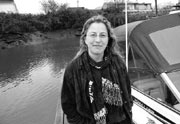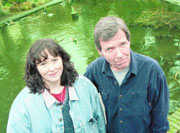SO WHO REALLY wants to go find out what’s in the water down on the lower Duwamish River? The dredged shipping channel that flows into Elliott Bay south of downtown is a forbidding place, walled in by concrete plants and heaps of scrap metal. Nearly as intimidating are the scientific reports documenting the high levels of pollution in the river—which the Environmental Protection Agency (EPA), the federal government’s chief environmental regulator, declared a Superfund cleanup site last September. Industry conscripted this waterway as a private dumping ground a century ago, and most people know little about what goes on there. But a coalition of community organizations is pushing to give the public a big say in how it gets cleaned up. The effort is testing the limits of the EPA’s disclosure policies, but the agency is going along—for now.
The Lower Duwamish riverbed contains levels of toxic metals, PCBs, and arsenic many times higher than what the state says is safe for fish and humans. Each year, 600 million gallons of untreated sewage and storm water drain into the river. Scientists have known all this for a long time, but local residents have mostly been left in the dark as to the toxic contents of the spewing drainpipes, plumes of smoke overhead, and petrochemical barrels piled on the banks. Some people still swim and fish in the Duwamish. Until last year, when the river was put on the Superfund list, no signs were posted warning them not to.
Last week, the Duwamish River Cleanup Coalition released a fact sheet detailing the levels of toxins in the river—a rare piece of information and a first step in what coalition coordinator B.J. Cummings says will be an ongoing campaign to shed public light on a complicated cleanup process. A former staffer for the Puget Soundkeeper Alliance, Cummings is one of the few who have closely observed chemical trails on the Duwamish; she used to track them back to their sources in a kayak. Cummings says industrial polluters typically have a huge information advantage over citizens during a Superfund cleanup: They hire the consultants who do the studies and write the cleanup plans. But on the Duwamish site, the Cleanup Coalition gets to see industry documents as soon as they are submitted to the EPA. That’s a major break from the past.
“Nowhere in the country have the people been invited in as early as in this case,” says Cummings. Citizen participation usually comes after the polluters have already made major decisions, she says. “And without that citizen input, the plans we get are crap,” says Cummings.
The Cleanup Coalition is already claiming a small victory in the Duwamish case. The group sent the EPA notice in November that it sharply disagreed with criteria proposed by the four major responsible parties—the Port of Seattle, the city of Seattle, King County, and Boeing—for selecting sites to schedule for immediate cleanup. The EPA agreed and asked the polluters for another design.
It’s too early to say whether the coalition is having a true impact—an EPA spokesperson says the agency probably would have requested the changes on its own—but Cummings says the relationships being formed could prevent protracted battles in the future. “It does make a huge difference,” she says. “We know that from what we’ve seen happen at other sites.”
Foremost in coalition members’ minds is the cleanup experience at the Rayonier mill site in Port Angeles on the Olympic Peninsula. The EPA ordered a cleanup of that site in 1997 but turned oversight duties over to the Washington state Department of Ecology. Darlene Schanfald, of the Olympic Environmental Council, says citizens have fought a losing battle to get Ecology to listen to their demands that Rayonier clean up affected areas more thoroughly than it’s doing. The citizens themselves, working unpaid in their spare time, were forced to discover on their own how badly their community was polluted, says Schanfald, with Ecology and the EPA only reluctantly acknowledging their findings. An Ecology spokesperson says the department has held the Rayonier cleanup to the highest possible standards.
Pam Johnson of People for Puget Sound says she wasn’t about to let the citizens be outgunned when the Duwamish was named a Superfund site. She and others applied for public and private grants to set up the Cleanup Coalition, complete with money to hire technical consultants and public outreach staff like Cummings. Seattle is the home of activists like John Beal, who’s been campaigning for 20 years to stop the polluters on the Duwamish. So have the Duwamish Tribe and the handful of activist groups that have joined the coalition.
EPA project manager Allison Hiltner says allowing citizen groups access to industry documents is a bit of an experiment. “It is a fairly new approach, and I think it represents an evolution in EPA’s thinking,” says Hiltner. But she warns that if the community gets overly worked up over reports that are incomplete or misinterpreted, her office might have to reconsider. Cummings agrees that the arrangement is precarious. “At this point, it’s relationship driven,” says Cummings. “Nothing says they can’t stop giving us documents tomorrow.”
Everybody may be getting along fine now, but the toughest challenges lie ahead, when cleanup standards are set and companies that are liable for the string of “hot spots” along the river are asked to pay up. “All of a sudden it won’t be so good to work with the community, because they’re not going to want the least-cost alternative,” predicts Johnson.








